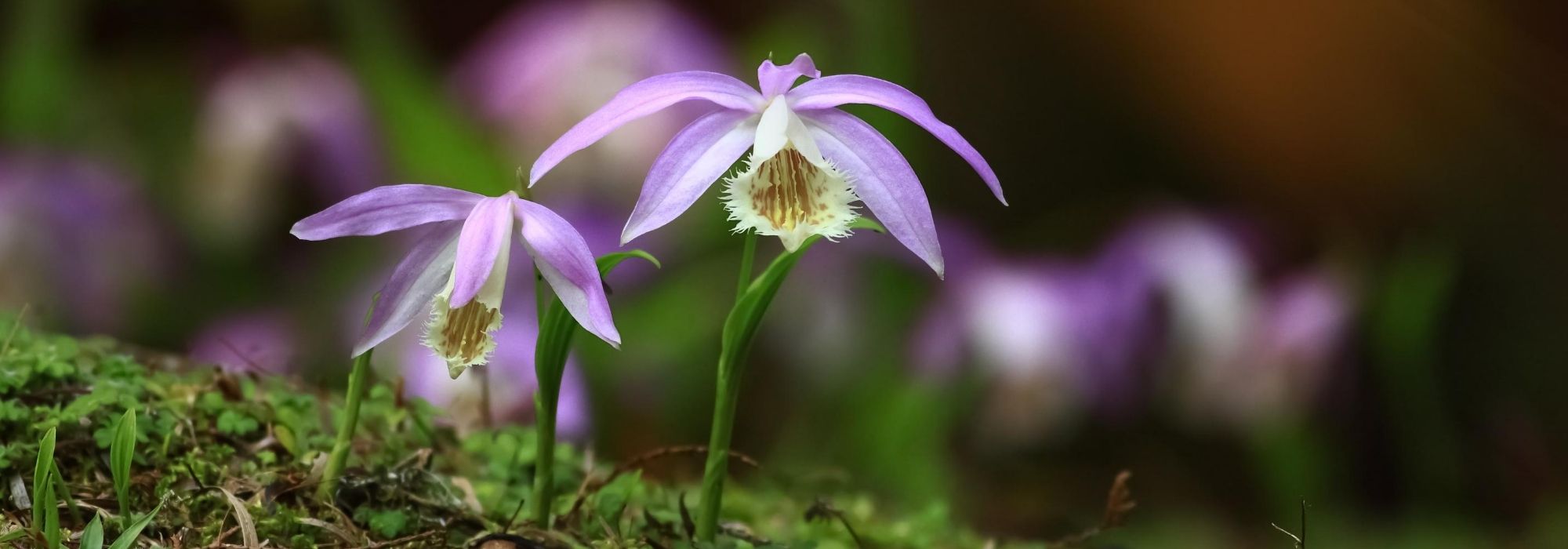
Pleione: planting, growing, and care
Contents
Pleiones in a nutshell
- These are semi-hardy orchids for open ground
- Pleiones prefer acidic soil and a partially shaded position
- The soil must be well-drained but never dry out in summer
- The colour of the flowers varies depending on the species or variety: white, pink, purple, yellow…
- These orchids can be grown in rockeries, under trees, or simply in pots
The word from our expert
Exotic-looking orchids in the garden, but you haven’t considered them? Yes, it’s entirely possible, particularly thanks to the genus Pleione.
Pleiones are semi-hardy garden orchids that can be grown outdoors in our latitudes if protected from severe cold and winter moisture. These charming flowers are all native to Asia. There are about twenty species, but Pleione formosana is the hardiest and can survive at least down to -5°C.
The colour of the large solitary flowers varies according to the species and variety, ranging from pure white to purple-pink, with some also available in shades of yellow. Pleiones are rhizomatous perennials with lanceolate leaves. Each spring, a single leaf and flower shoot emerge from a pseudo-bulb which, after flowering, will produce a new pseudo-bulb, thus perpetuating the species.
Pleiones prefer well-drained, rather acidic soils and a partially shaded position. They can be grown in rock gardens, under trees, in miniature gardens, or more simply in pots. The latter method of growing Pleiones at home has the advantage of being able to bring your orchids into a cold greenhouse at the first signs of frost.
Description and botany
Botanical data
- Latin name Pleione sp.
- Family Orchidaceae
- Common name Pleione
- Flowering from March to May depending on the species
- Height 15 to 20 cm
- Exposure full sun to partial shade
- Soil type acidic and well-drained
- Hardiness down to -5°C
Pleiones are part of the Orchidaceae family and more specifically belong to the subfamily Epidendroideae. These are small orchids native to the humid subtropical forests at high altitudes (between 1,000 and 3,300 m) around the Himalayan range, found in northern India, Myanmar, southern China, Thailand, and Laos. The genus Pleione currently includes about twenty species that are either epiphytic (growing on other plants) or lithophytic (living directly on rocks).
Pleiones are sympodial plants, meaning that the plant will branch in such a way that the apical bud degenerates, forcing the plant to grow in a “zigzag” pattern through the development of lateral buds. The plant develops on a pseudobulb. The foliage is deciduous, disappearing in winter.
Their relatively small size, rarely exceeding 15 cm in height, makes the flowers of Pleione appear monstrously large. The flowering features a tubular lip with fringed edges up to 8 cm long. This lip is surrounded by long, thin sepals and petals that range in colour from white to mauve.
Depending on the species, each pseudobulb will produce one to two leaves and only one to two flowers. Unfortunately, these flowers will only brighten your garden for about fifteen days in early spring. But what jewels they are!
Due to their natural origins, these orchids should be grown in a cool greenhouse with a winter rest period. However, in temperate regions, it is possible to keep them in the garden in a rockery or under trees. Although biologically more epiphytic, Pleiones can be grown in the ground like other garden orchids (such as Cypripediums, for example).
From the end of winter, sometimes as early as March, growth resumes vigorously, producing new young shoots. Flowering occurs quickly in May-June, sometimes even a bit earlier. After this flowering, the orchid will produce its leaves (10 to 20 cm long) to continue its vegetative cycle and other pseudobulbs from the first. In autumn, the leaves will yellow and fall, and Pleiones enter winter dormancy. The orchid then seems to completely disappear, surviving underground only through its pseudobulbs. In spring, the new bulb(s) formed will start their growth, and so on year after year.

Some Pleiones
The main species of Pleiones
- Pleione aurita
A Pleione with dark pink petals and sepals surrounding a pink lip, the centre of the lip featuring an orange colouration. This species is native to western Yunnan (China).
- Pleione bulbocodioides
The most typical of the genus Pleione, with its large intense pink flowers featuring a fringed lip spotted red on the inside. This species is native to the mountains of China and Tibet.
- Pleione formosana or Formosan Pleione or Window Orchid
This Pleione is native to Taiwan, China, and can be found as far as the Himalayas. The flowers are slightly pink, veined with white, with a fringed lip that is sometimes spotted red on the inside. The shapes and colours vary greatly depending on the geographical origin of the species. Notably, there is a white variety named ‘Alba’.
- Pleione grandiflora
The Large-flowered Pleione boasts, as its name suggests, very large flowers for the genus. The colour ranges from white to lavender pink with a heart often yellow. It can be found in nature from southern Yunnan (China) to northwestern Vietnam.
- Pleione hookeriana
Very close to Pleione humilis, its flowers are pure white with a bit of yellow in the lip. Its geographical origin ranges from Nepal to southern China.
- Pleione humilis
This is certainly one of the most beautiful species of the genus Pleione, with its cream-white flowers featuring a mauve interior. This species, native to East Asia, is characterised by very early flowering, sometimes as early as February.
- Hybrid Pleiones
Some hybrid Pleiones also exist. They are known as ‘Verdi’, ‘Tongariro’, or ‘Rossini’ for the most well-known.
Read also
Planting bulbs of PleionesThe main species and varieties of Pleiones
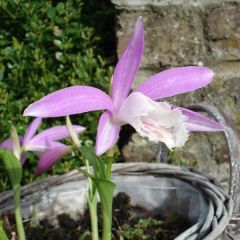
Pleione formosana
- Flowering time May, June
- Height at maturity 15 cm
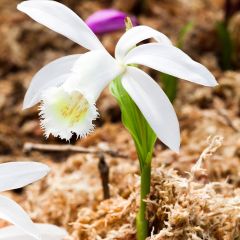
Pleione formosana Alba - Windowsill orchid
- Flowering time May, June
- Height at maturity 15 cm
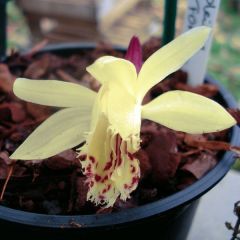
Pleione forrestii
- Flowering time April, May
- Height at maturity 15 cm
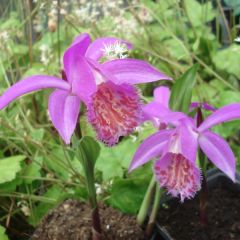
Pleione Tongariro bulbs
- Flowering time May, June
- Height at maturity 15 cm
Discover other Pleione
View all →Available in 2 sizes
Available in 0 sizes
Available in 1 sizes
Available in 1 sizes
Available in 1 sizes
Planting Pleiones
Where to plant?
If possible, in a semi-shaded position. The sun is beneficial for them early in the morning and late in the day, but the base of a tree with light foliage will be perfect to limit sun exposure during the hottest hours.
It is possible to grow pleiones in full sun, but only in the north of the Loire and if the soil remains very moist, such as near a water source. However, be cautious of summer sun, which can quickly burn and completely dry out the plant.
Pleiones are semi-hardy and can be planted outdoors in the ground in certain regions. However, if frosts of -8/-10 °C persist for several days, the bulbs may freeze. Growing in pots or containers is therefore preferable to allow you to bring your pleiones into a cold greenhouse.
When to plant?
The planting of pleiones takes place in winter, outside of frost periods, during the vegetative rest of the pseudo-bulbs. Never move a pleione when it starts its growth in spring!
How to plant?
Depending on the species, pleiones do not all grow on the same support (rocks, trees, or directly in the soil). However, you can grow all pleiones in the same substrate: in the ground, a pocket of good light, humus-bearing, and porous potting mix that retains moisture well will be ideal. In pots, choose a special orchid potting mix supplemented with a bit of pumice for drainage. Keep in mind that the container should be wide enough as the new bulbs will grow around the old mother bulb.
Place your pseudo-bulbs in the substrate or soil about every 15 cm, leaving 1/3 of the bulb above the surface.
In pots or in the ground, you can cover your pseudo-bulbs with a thin layer of chips. In autumn, a good mulch of fallen leaves will help them get through the winter safely if you do not bring them in.
→ Learn more about the growing Pleione in pots in our article.
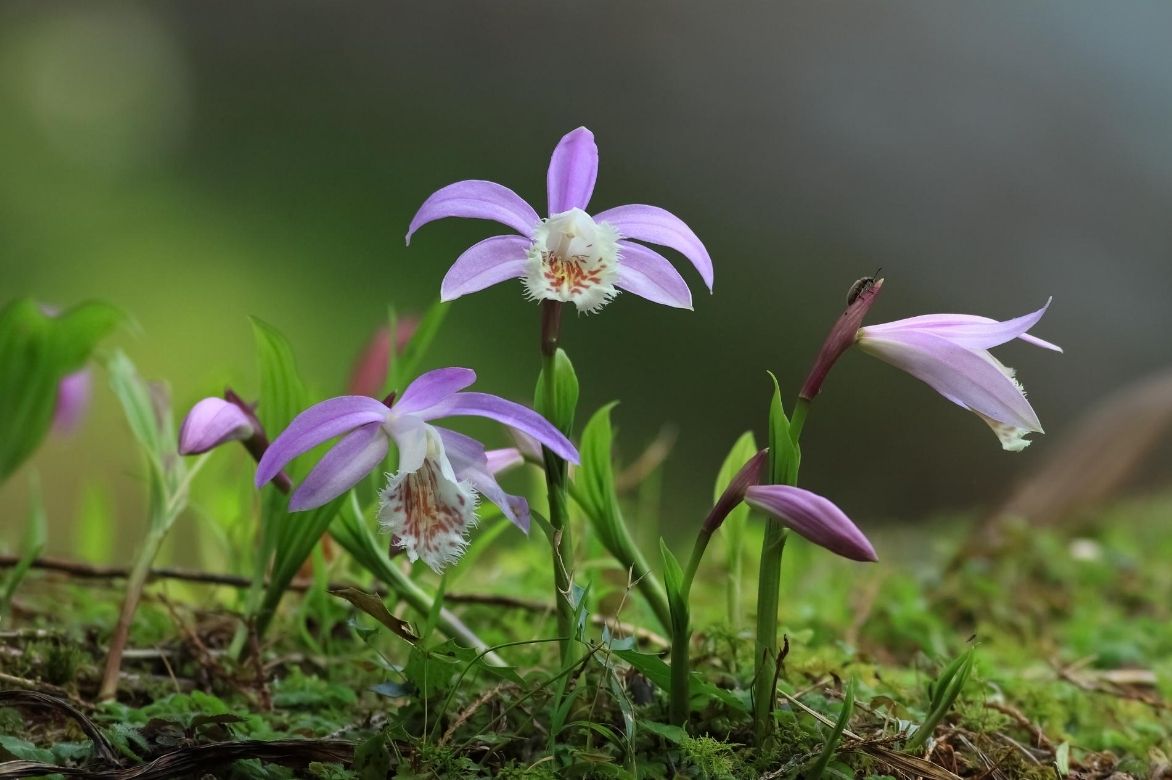
Maintenance and care
Watering
Watering should only be moderate at the start of growth. Afterwards, it is essential to keep the substrate or soil moist during flowering and until the leaves begin to yellow. As soon as they fall, stop watering until growth resumes!
Pleiones, like all orchids, have high water requirements. The watering water should, if possible, be low in minerals and slightly acidic. The ideal is collected rainwater.
Care
As soon as the first severe frosts arrive, place your potted pleiones in a cold greenhouse (between 1 and 4°C) but frost-free. You can bring your pots out again around early April or later depending on your climate.
During the warm season, you must ensure to keep your pleiones below a temperature of 25°C by any means: shading, daily misting, ventilation…
You should cut the flower stem flush with the leaves when the flower fades. Leaving the flower would unnecessarily drain energy from the bulb.
Repotting is done during the dormant period in winter. As soon as the new shoots start to grow: do not touch them! A broken pleione root will never be replaced.
A simple NPK 15-15-15 horticultural fertiliser will be sufficient throughout the growth period. If you want to be particular, you might say that fertilisation should be richer in phosphate at the beginning of growth and then richer in nitrogen and potassium after flowering.
Potential diseases and pests
No pests to consider. At most, slugs might be tempted by the first shoots, but this is quite rare.
Botrytis, grey mould, may appear on flowers in poorly ventilated greenhouses. There is no risk in open ground.
Too much light or insufficient humidity can cause leaf necrosis: they become soft and develop elongated brown spots. It is advisable to move pleiones immediately if they are in pots or, in winter, for outdoor cultivation.
Multiplication of Pleiones
Forget about sowing, which is too complicated and unpredictable!
Division of Pleiones
The division will take place during the dormant period in winter.
Remove the plant from its pot and take off some of the substrate, being careful not to damage the roots. If your pleiones are in soil, dig them up using a dibber or a spade. Cut a section of the rootstock that includes roots and one or more pseudo-bulbs with a clean, sharp blade. You can seal the cut wound with an antiseptic solution to prevent diseases.
You can also remove any dried old roots and dead leaves. Afterwards, you can repot or place your newly divided young plants in well-moistened, but not waterlogged, substrate.
How to pair pleiones?
In pots or containers
This is the simplest solution for growing pleiones, especially if you live north of the Loire, in Switzerland, or Belgium. Choose beautiful lacquered containers to place on a wrought iron table with an old-world charm. Pleiones are particularly well showcased in large “bonsai” type containers. Firstly, you can try two lovely pleiones whose flowering will follow one another: Pleione forestii, which blooms lemon yellow with a purple heart between March and April, and Pleione ‘Tongariro’, which blooms fuchsia pink between April and May. These orchids are collector’s plants, so it would be inappropriate to add ordinary neighbours. A beautiful pot of Hosta ‘Praying Hands’ with rolled and slender bright green leaves edged in cream-yellow, along with a small tuft of Leptinella squalida ‘Platt’s Black’, an amazing plant reminiscent of ferns, will bring a touch of freshness around the orchids. To finish on an exotic note, an Arisaema concinnum with its original flowering will tastefully accompany the flowering of your pleiones.
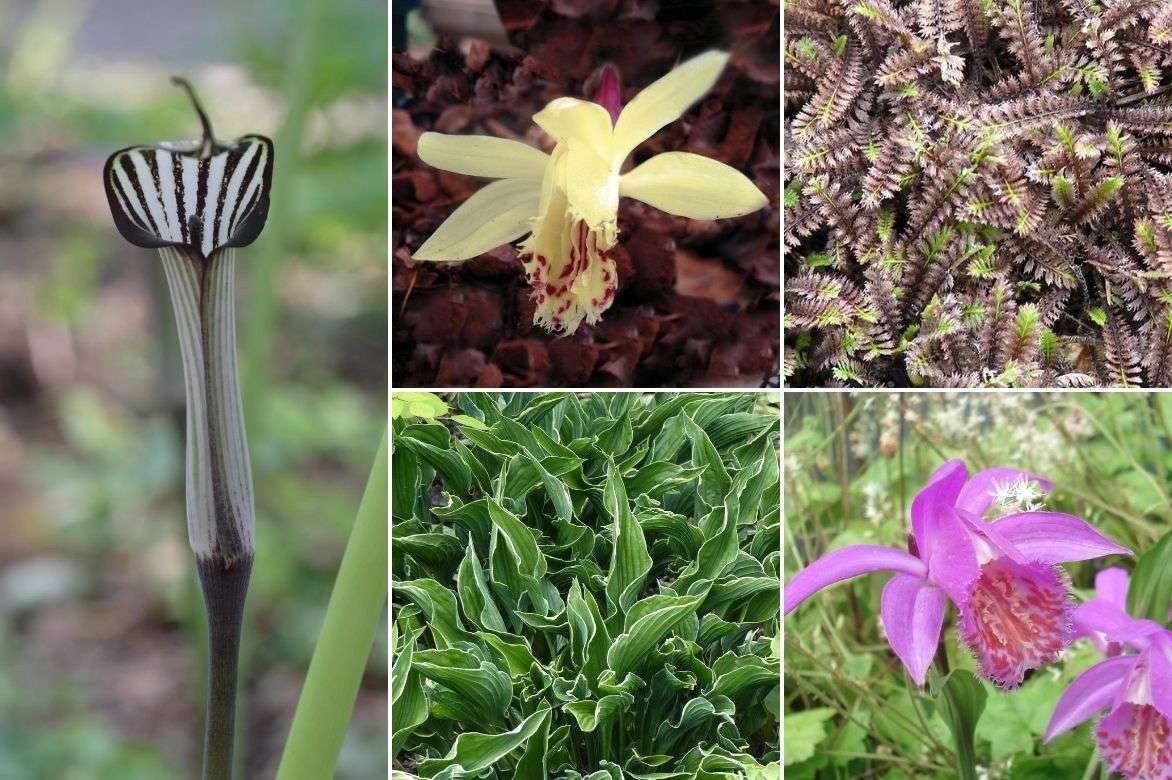
An idea for pot or container association: Arisaema concinnum, Pleione forestii, Pleione Tongariro, Hosta ‘Praying Hands’, and Leptinella squalida ‘Platt’s Black’
In the ground under a light-foliaged tree
Do you live in a mild climate with acidic, well-drained soil? Then, find a beautiful light-foliaged tree in your garden and plant a cluster of Pleione formosana ‘Alba’, a variety with immaculate white flowers. Plant them in small odd groups: 3, 5, 7… to start. If they thrive, you will soon have a true “field” of orchids. Especially if you accompany them with a few other white Asian and semi-hardy orchids: Calanthe aristulifera. To succeed the sadly ephemeral flowering of the pleiones, you might try an unknown perennial with a few tufts of Dianella revoluta ‘Coolvista’, which will provide blue flowers with a yellow heart throughout the summer. To bridge the flowering of the pleiones and that of the Dianella, what could be better than a hardy geranium (flowering May-June): for example, this spectacularly exotic Geranium maderense with pink flowers that will reach over a metre in height. But the important thing under a tree is to have a decor that remains beautiful all year round. In this case, Vinca difformis will provide a vigorous, persistent groundcover punctuated by star-like blue flowers almost all year round.
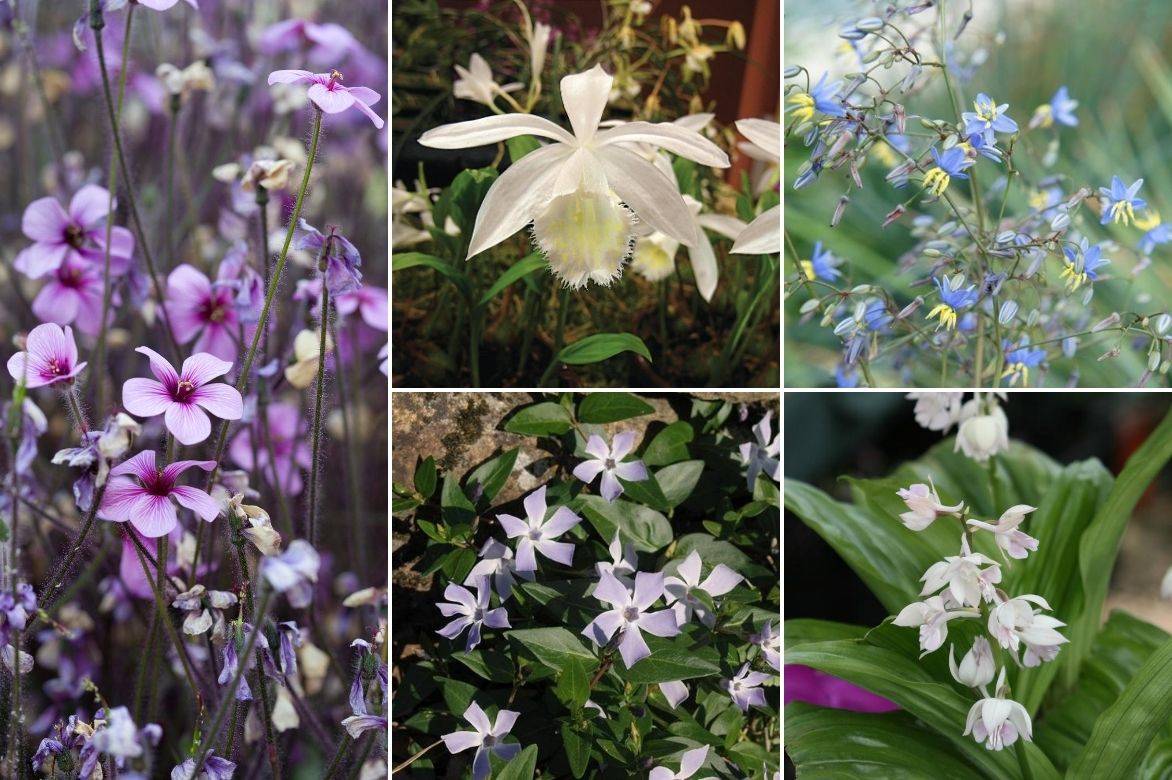
An idea for association in the ground under light shade: Geranium maderense, Pleione formosana ‘Alba’, Dianella revoluta ‘Coolvista’, Vinca difformis, and Calanthe aristulifera
In semi-shaded rockeries
Pleiones are plants for semi-shaded rockeries, which is quite unusual. Fortunately, other perennials have the same needs. The typical species of Pleione formosana will feel right at home alongside a lovely collection fern for fresh rockeries: Adiantum aleuticum ‘Imbricatum’. The Canadian Anemone is a vigorous little groundcover that also thrives in shady rockeries and rewards us with vigorous white star-like flowers from May to July. A few scattered tufts of Gentiana makinoi ‘Blue Star’, a Japanese gentian with blue flowers that last all summer, will add a touch of azure to the ensemble. The evergreen foliage of some Carex flacca will be perfect at the highest point of the rockery, where it can cascade naturally.
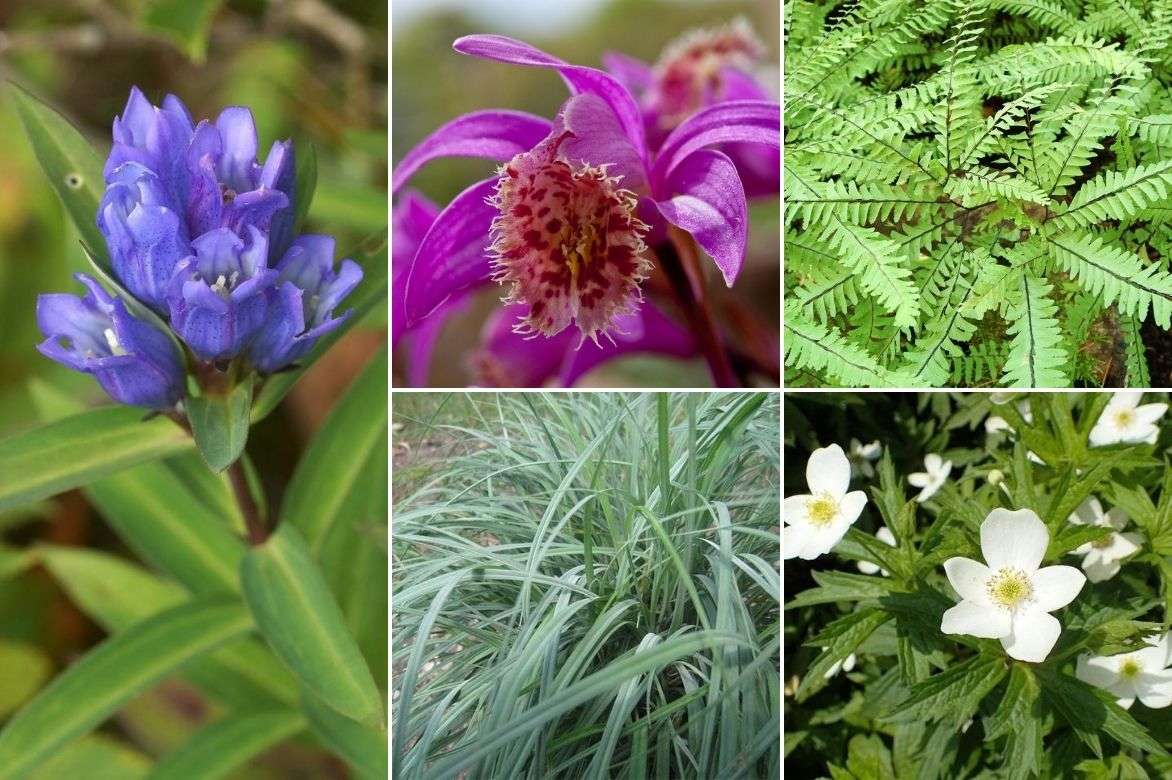
An idea for association in semi-shaded rockeries: Gentiana makinoi (like ‘Blue Star’), Pleione formosana, Adiantum aleuticum ‘Imbricatum’, Carex flacca, and Anemone canadensis
“`
Did you know?
- The genus Pleione is named after a character from Greek mythology: the mother of the seven Pleiades, the oceanid Pleione.
- The name Pleione is also that of a star in the constellation Taurus.
- Never put dead leaves from orchids in your compost, as they contain calcium oxalate, which is harmful to the wildlife that lives there (and helps create your compost!).
- The species name “formosana” refers to Formosa, the former name of the island of Taiwan.
Useful resources
- Find all our pleiones in our online nursery.
- Discover our 3 ideas to pair pleiones
- Explore hardy orchids to grow in the garden!
Frequently asked questions
-
Can I grow pleiones in the ground?
It is possible in regions with a mild climate. Pleione formosana is the hardiest and can survive in the ground down to -5°C. The other Pleiones are even more sensitive and generally do not tolerate temperatures below -1°C. Let’s not forget the needs of the plant: a slightly sunny or partially shaded position, as well as acidic, very well-drained but consistently moist soil. If all these conditions are met, there is no reason not to try these orchids in the garden. In the north of the Loire, we would recommend growing your Pleiones in pots and bringing them into a cold greenhouse during the dormancy period.
-
My soil is heavy: what should I do?
Pleiones are sensitive to stagnant moisture, especially in winter. If you wish to plant these orchids in the ground at home, you will need to improve drainage in the planting hole using good potting compost and a bit of pumice. Otherwise, pot planting is highly recommended, allowing you to better manage the substrate.
- Subscribe!
- Contents
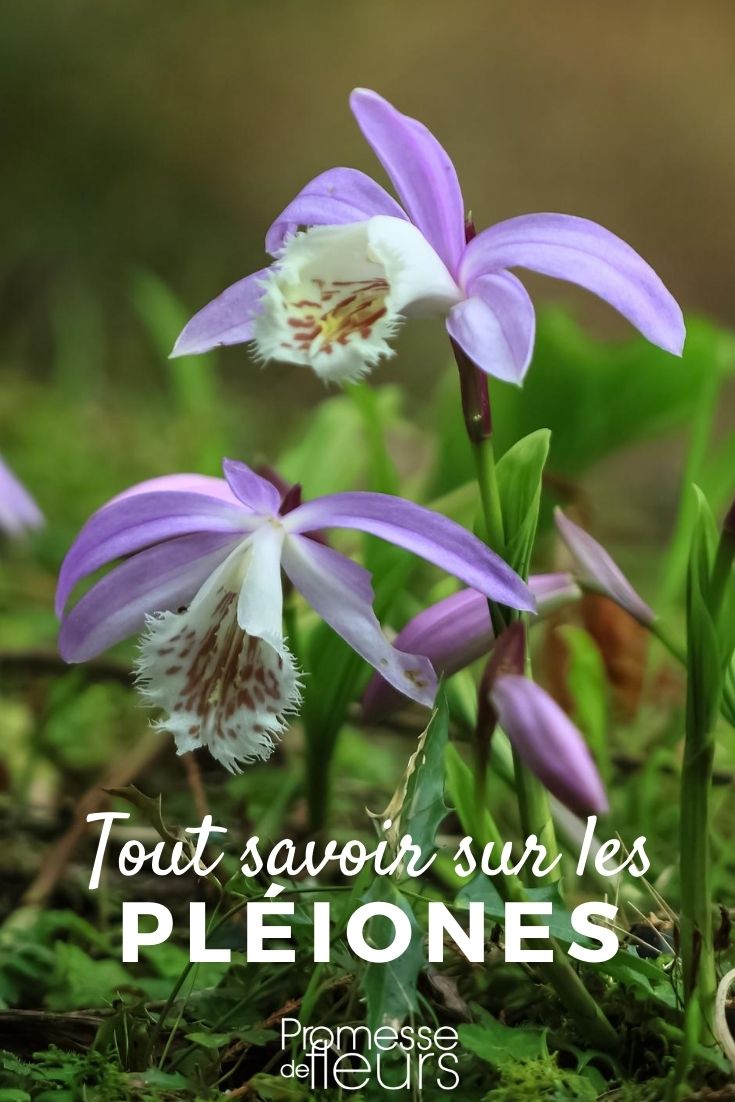
































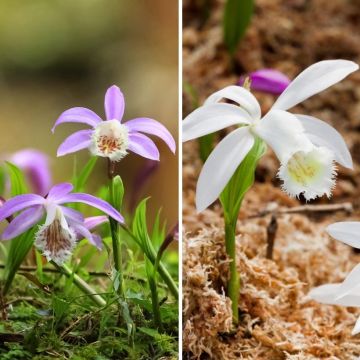



Comments